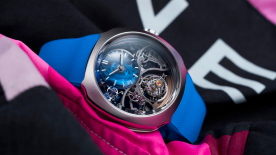It is perhaps because of the incomplete statistics about the industry that some armchair experts find it easy to back up their repeated forecasts of doom and gloom for the Swiss Watch industry. After all, Swiss watch export figures published by the Swiss Watch Industry Federation have been dropping every month since last summer and the rise of smart watches, led by those of the juggernaut of technology companies, Apple, is slowly eating away at the Swiss watch industry’s market share. Two major trends that are enough to confidently predict a crisis in the industry, surely?
The annual report published by Vontobel, a Swiss bank, prefers to analyse the market in much more detail – a detail that runs to some 80 pages and is intended to help investors make informed decisions on where their capital will earn the best return. Analyst René Weber has been following the watch industry for more than 20 years and has excellent contacts with its stakeholders. “After publication of our forecasts, we get feedback from various people in the industry which we collect,” he explained to WorldTempus. “We believe our assumptions for the different brands in terms of sales and units are therefore quite accurate. But of course, we know our figures are not 100% correct, but they should at least be a very good guess for the individual brands.”
Swiss watch exports: the complete picture
Swiss watch export figures as a whole are in decline and for the country’s main export market, Hong Kong, the situation is indeed dramatic, not least because of the huge inventories (in excess of 200 days in some cases, according to Vontobel) that are being carried by the major distributors. In response to these huge inventories, watch brands are obliged to exchange stock before customers will re-invest, thus sacrificing part of their margin. Yet exports to Europe, even in the wake of last year’s terrorist atrocities in France, have increased so far this year, as have exports to Japan, the UAE and Saudi Arabia. Vontobel puts the compound annual growth rate (CAGR) for the Swiss watch industry from 2010-2015 at 5.9%, despite the decline last year.
By their very nature, of course, export figures for the Swiss watch industry take no account of the domestic market, which Vontobel estimates at around 6% of total exports by value, making Switzerland one of the biggest markets for watch sales in Europe, at the same level as France, Germany and Italy. “Switzerland had a rather good year in 2015,” says Mr Weber, “very much driven by tourist demand, especially from Chinese visitors. We believe that places like Lucerne and Interlaken benefitted from the rise in the number of Chinese tourists travelling to Switzerland (Chinese arrivals in Switzerland increased 36% in 2015). Since December 2015, however, Chinese arrivals have declined and led to a sales decrease in the first quarter of 2016.”
Smartwatches: boom or bust?
The Vontobel report includes smart watch sales figures for the first time, although analyst René Weber admits that this was more “for amusement” than for consideration as competitors with high-end Swiss watches, with the report reaffirming that smart watches are “not an issue for Swiss high-end brands”. According to figures from IDC, Apple has shipped 11.6 million Apple watches, generating an impressive 4.5 billion US dollars in revenue. The Apple Watch thus drives a wedge between Rolex and Omega to become the second biggest-selling watch brand in the world in 2015. But the Swiss high-end brands only account for 0.6% of global watch sales and the top brands only sell hundreds of thousands of watches, not the millions that Apple does. This is significant because when Apple announced a 15% price reduction for the Apple Watch at the end of March 2016 to compete with the latest Fitbit offering priced at 200 dollars, it took an immediate half a billion dollar hit in revenue based on the above sales figures. Furthermore, while talk of Richemont shedding jobs at its Swiss brands made the headlines in Switzerland, there has been little mention of the fact that smart watch pioneer Pebble has cut its staff by 25% and fitness tracker producer Jawbone laid off 15% of its workforce at the end of last year.
Double-digit growth in a crisis?
In spite of the difficult economic climate, the Vontobel report singles out three brands that each experienced double-digit growth last year. Richard Mille increased its sales by 22%, Hublot by 14% (confirmed by CEO Ricardo Guadalupe in his interview with WorldTempus) and Audemars Piguet by 12%. All three are characterized by their use of cutting-edge technology and materials, their distinctive designs and powerful marketing. But that is not the only thing they have in common: “All three brands have a limited exposure to Greater China,” René Weber explains, “and have therefore not been as negatively impacted as brands with a high sales exposure to Hong Kong. Hublot, for instance, only started selling in Hong Kong in 2011. In addition, all three brands have found their niche in the high end and are produced in small volumes which are not comparable to the large brands.”
The Vontobel report shares the Worldtempus view that the mood at Baselworld this year was “cautiously optimistic” (we said we were “pleasantly surprised”). Once again, this is a view far removed from the scare-mongering of some self-styled industry experts but it is one that is also accompanied with three pages of disclaimers and disclosures that expressly indicate sources, potential conflicts of interest, global rating breakdowns by the analysts and full details of the report methodology. So when Vontobel, a publicly-listed company, goes on record with forecasts of a decline in the first half of 2016 to be compensated by an upturn in the second half of the year, leading to a flat performance in 2016, it is a claim that is built on some considerable substance.





